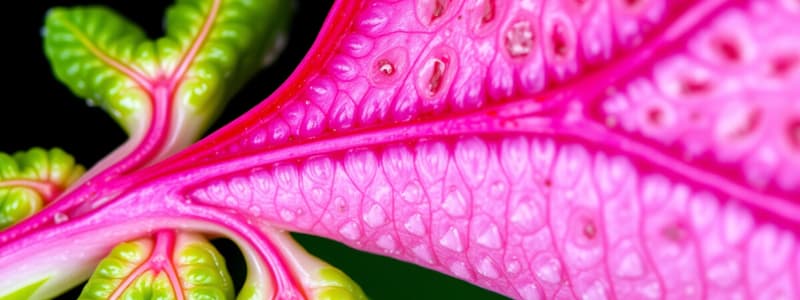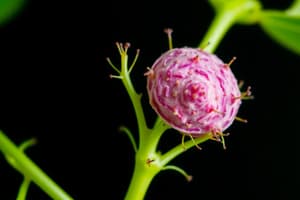Podcast
Questions and Answers
What is a primary characteristic of meristematic tissues?
What is a primary characteristic of meristematic tissues?
- They have a large intercellular space.
- They are metabolically inactive.
- They consist of fully differentiated cells.
- They are composed of immature, continuously dividing cells. (correct)
Which type of meristematic tissue is responsible for the axial growth in plants?
Which type of meristematic tissue is responsible for the axial growth in plants?
- Intercalary meristem
- Vascular cambium
- Lateral meristem
- Apical meristem (correct)
What describes the cells of meristematic tissues?
What describes the cells of meristematic tissues?
- They are mature cells with thick walls.
- They are inactive with sparse cytoplasm.
- They are large with minimal cytoplasm.
- They have negligible intercellular space. (correct)
Where is the intercalary meristem located in plants?
Where is the intercalary meristem located in plants?
Which of the following is an example of lateral meristem?
Which of the following is an example of lateral meristem?
What is a main function of intercalary meristem in plants?
What is a main function of intercalary meristem in plants?
Which characteristic distinguishes meristematic tissues from permanent tissues?
Which characteristic distinguishes meristematic tissues from permanent tissues?
Which type of meristematic tissue is responsible for radial growth in plants?
Which type of meristematic tissue is responsible for radial growth in plants?
Where are apical meristems primarily located?
Where are apical meristems primarily located?
What is a defining feature of meristematic cell walls?
What is a defining feature of meristematic cell walls?
What role do lateral meristems play in plant structure?
What role do lateral meristems play in plant structure?
Which of the following statements about meristematic tissues is true?
Which of the following statements about meristematic tissues is true?
What type of growth do intercalary meristems contribute to?
What type of growth do intercalary meristems contribute to?
Which plant structures are primarily affected by apical meristems?
Which plant structures are primarily affected by apical meristems?
What is the primary type of cell found within meristematic tissues?
What is the primary type of cell found within meristematic tissues?
Flashcards are hidden until you start studying
Study Notes
Meristematic Tissues Overview
- Composed of immature, undifferentiated cells that continuously divide.
- Found primarily at shoot and root tips in plants.
Characteristics of Meristematic Tissues
- Consist of small, immature cells.
- Highly active metabolism, characterized by dense cytoplasm.
- Minimal to negligible intercellular spaces.
- Thinner cell walls with distinct, prominent nuclei.
Types of Meristematic Tissues
-
Apical Meristem:
- Located at tips of stems, roots, and branches.
- Responsible for axial (vertical) growth of the plant.
-
Intercalary Meristem:
- Situated at the base of internodes.
- Facilitates growth in the internodal regions.
-
Lateral Meristem:
- Found on the lateral sides of stems and roots.
- Responsible for radial (width) growth of the plant.
- Includes vascular cambium and cork cambium as examples.
Meristematic Tissues
- Defined as a group of immature and actively dividing cells located at specific regions in plants.
- Essential for plant growth and development, primarily found in shoot and root tips.
Characteristics of Meristematic Tissues
- Composed of undifferentiated cells, allowing for growth and development.
- Cells are small and metabolically active, featuring dense cytoplasm.
- Minimal to no intercellular space between cells.
- Thinner cell walls that allow for flexibility, with a prominent nucleus.
Types of Meristematic Tissues
-
Apical Meristem:
- Located at the tips of stems, roots, and branches.
- Responsible for vertical/axial growth (increasing height).
-
Intercalary Meristem:
- Found at the base of internodes.
- Facilitates growth in the internodal regions, contributing to lengthening of stems.
-
Lateral Meristem:
- Positioned on the sides of stems and roots.
- Responsible for radial growth (increasing thickness).
- Includes vascular cambium and cork cambium.
Studying That Suits You
Use AI to generate personalized quizzes and flashcards to suit your learning preferences.




